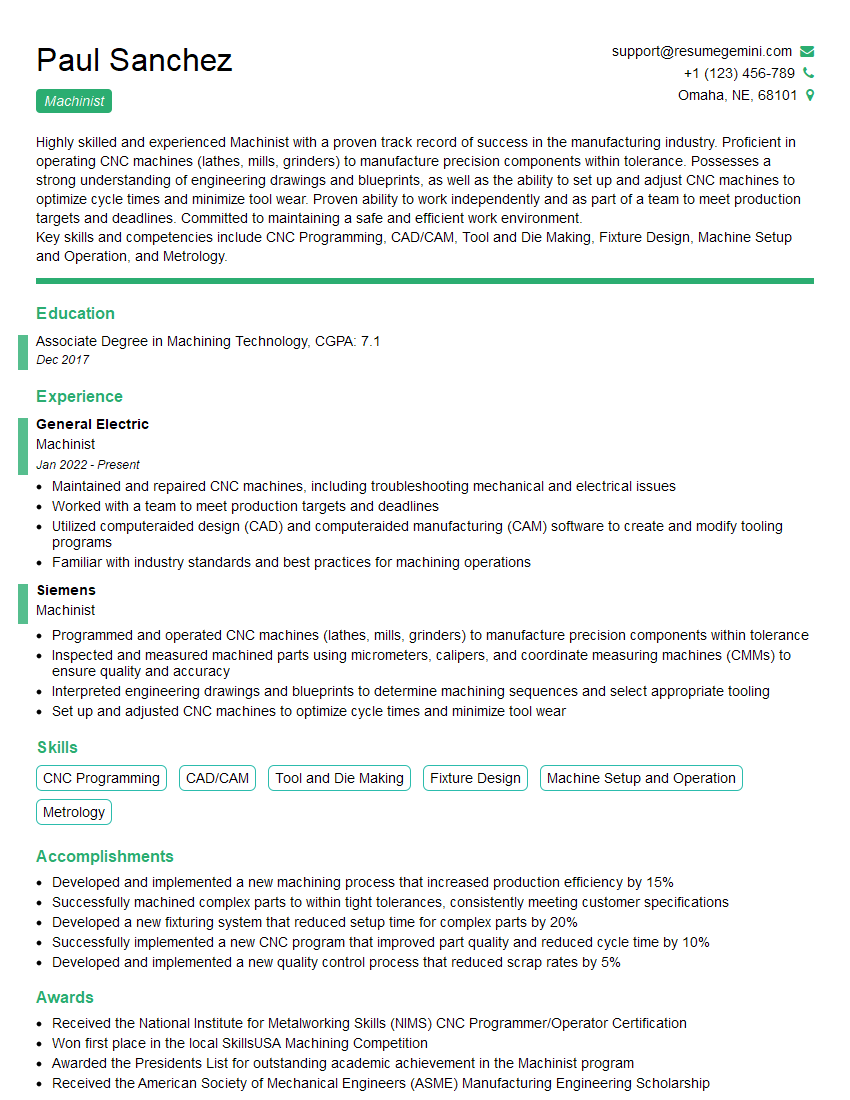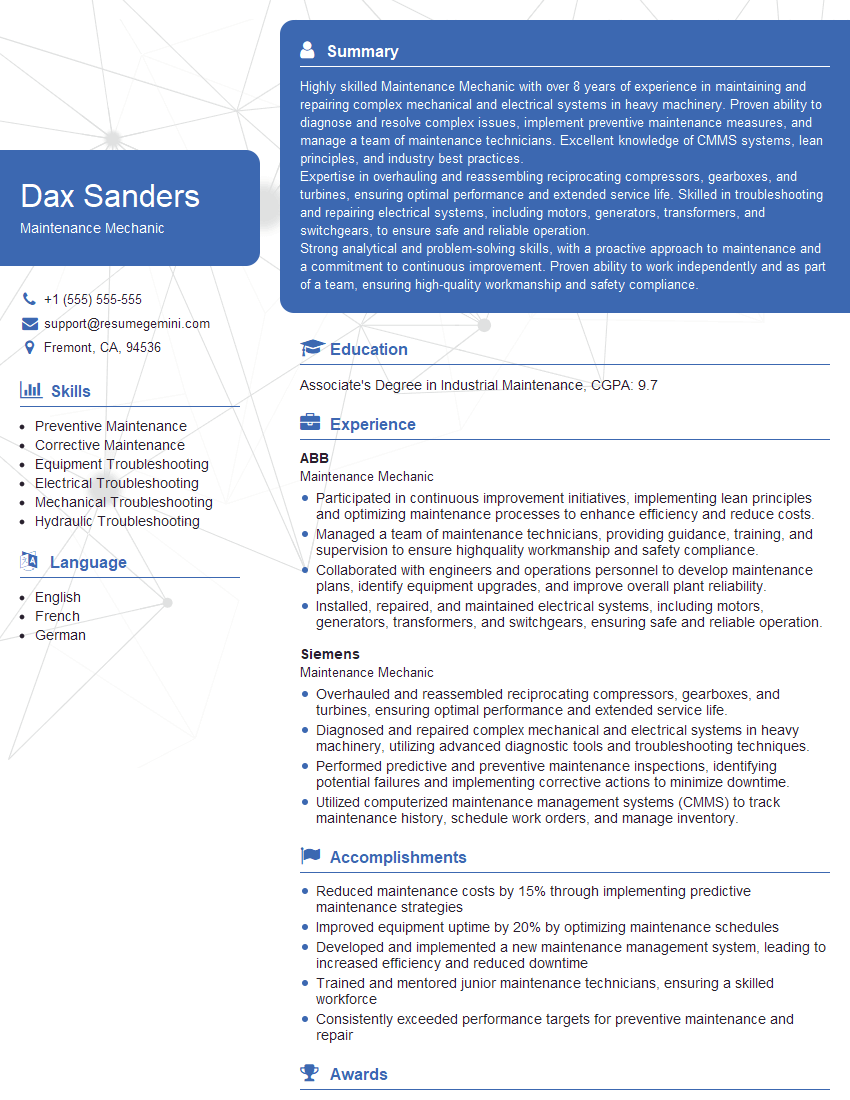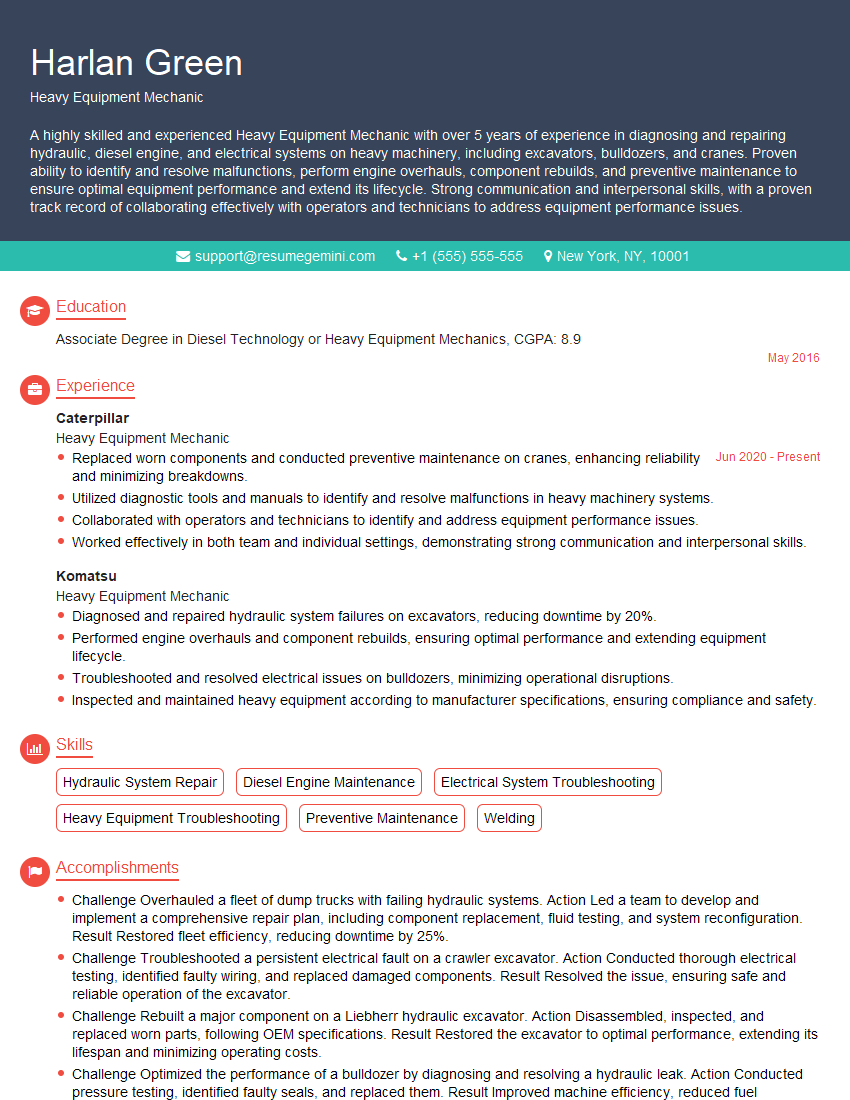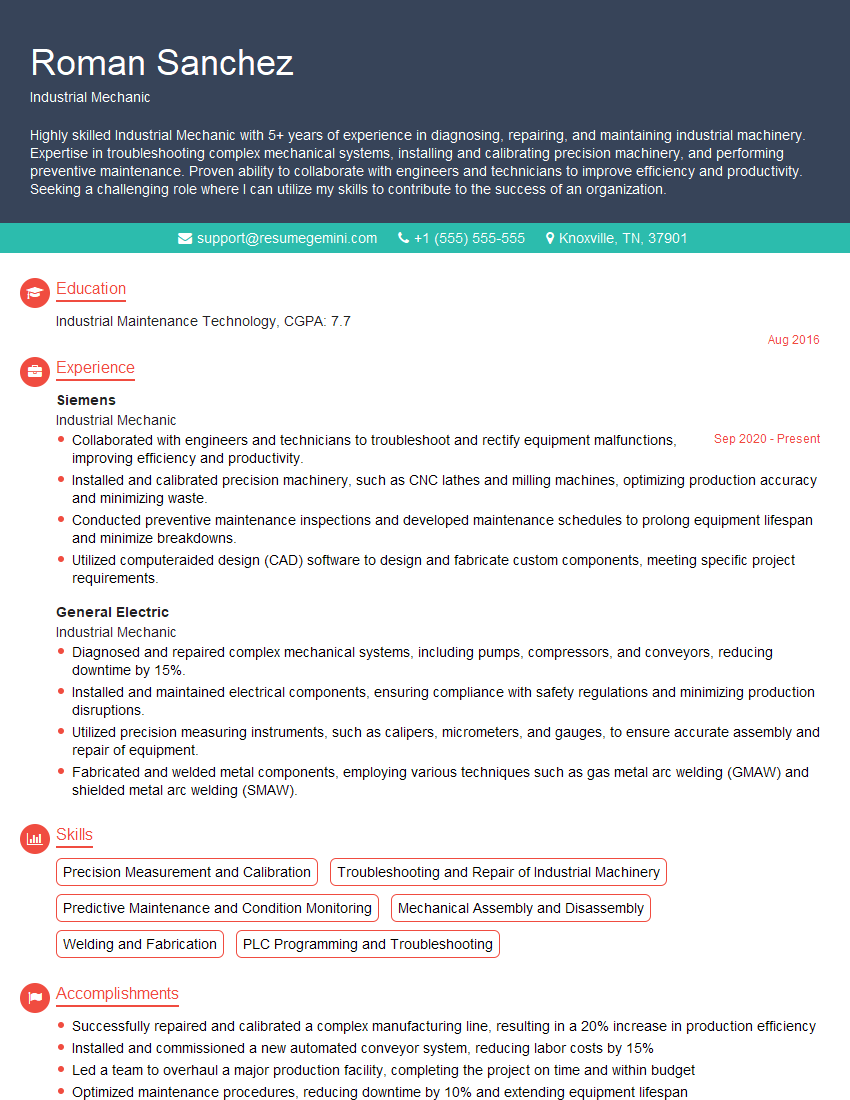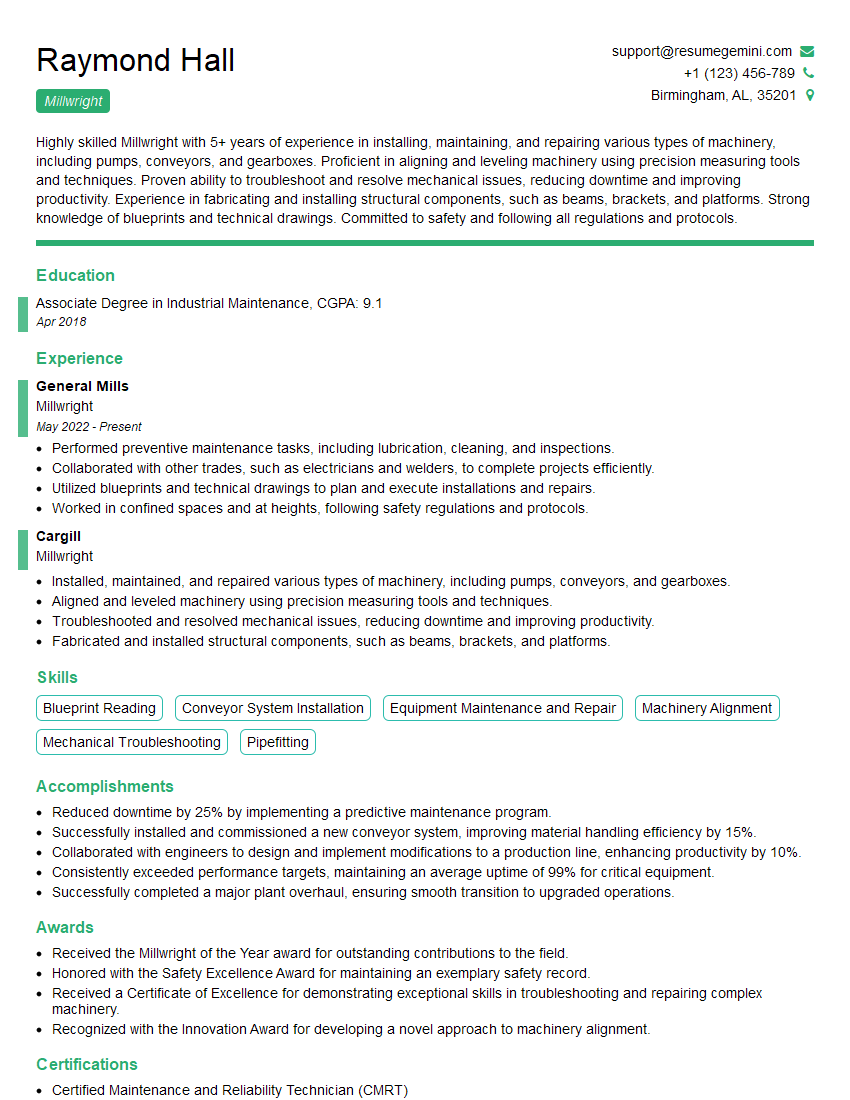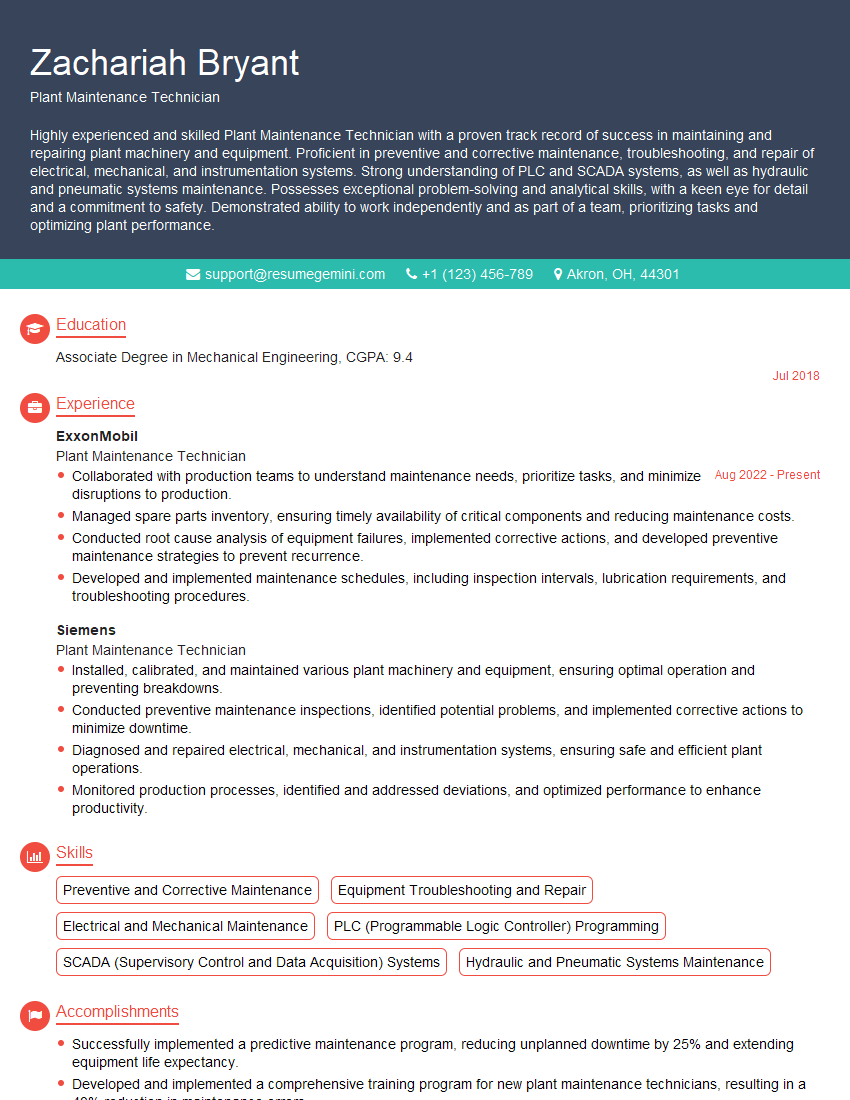Interviews are more than just a Q&A session—they’re a chance to prove your worth. This blog dives into essential Bearings and Seals Replacement interview questions and expert tips to help you align your answers with what hiring managers are looking for. Start preparing to shine!
Questions Asked in Bearings and Seals Replacement Interview
Q 1. Explain the different types of bearings and their applications.
Bearings are essential mechanical components that reduce friction and support rotating shafts. They come in various types, each suited for different applications. Think of them as the joints allowing smooth movement in machines, from tiny electronics to massive industrial equipment.
- Ball Bearings: These utilize rolling spherical balls between inner and outer rings. They’re excellent for high-speed applications and offer low friction, commonly found in bicycles, automotive wheels, and precision instruments.
- Roller Bearings: Instead of balls, these use cylindrical or tapered rollers. They handle heavier radial loads than ball bearings, making them suitable for applications like conveyor systems, industrial machinery, and vehicle axles. Tapered roller bearings are particularly good at handling both radial and thrust loads.
- Plain Bearings (Sleeve Bearings): These consist of a bearing surface (often a metal bushing) and a rotating shaft. They’re simple, cost-effective, and suitable for low-speed, low-load applications like pumps and small motors. However, they have higher friction and require more frequent lubrication.
- Thrust Bearings: These are specifically designed to handle axial loads (forces pushing on the shaft end). They prevent axial movement and are commonly used in applications like propeller shafts or vertical pumps.
The choice of bearing depends critically on the load (radial, axial, or combined), speed, operating temperature, required lifespan, and overall cost constraints. For example, a high-speed motor might need a precision ball bearing for minimal friction and noise, while a heavy-duty crane would benefit from sturdy roller bearings.
Q 2. Describe the various types of seals and their suitability for different environments.
Seals are crucial for preventing leakage of fluids (lubricants, coolants, etc.) or contaminants (dust, debris) from entering mechanical systems. Different types of seals are suited to various environments and operating conditions.
- O-Rings: Simple, versatile, and inexpensive elastomeric seals creating a tight fit between mating surfaces. Suitable for low-pressure applications and static sealing. However, they are susceptible to wear and tear, especially at higher pressures and temperatures.
- Lip Seals (Radial Shaft Seals): These are commonly found in rotating shafts and prevent leakage between the shaft and housing. They utilize a flexible lip that contacts the shaft, creating a seal. Their effectiveness depends on proper shaft finish and lubrication.
- Mechanical Seals: These are precision-engineered seals using stationary and rotating faces pressed together to create a tight seal. They are robust and durable, capable of handling high pressures, temperatures, and speeds. These are commonly used in pumps, compressors, and other critical applications.
- Gasket Seals: These are flat seals made from various materials, providing a seal between two flat surfaces. They are commonly found in housings and flanges. The effectiveness depends heavily on the surface flatness and the gasket material’s properties.
Consider factors like pressure, temperature, chemical compatibility, and speed when selecting a seal. A high-pressure hydraulic system might need a robust mechanical seal, while a low-pressure system might be adequately sealed with an O-ring.
Q 3. What are the common causes of bearing failure?
Bearing failure can stem from several causes, often stemming from a combination of factors. Preventing these requires careful design, selection, and maintenance.
- Improper Lubrication: Insufficient or contaminated lubricant leads to increased friction, overheating, and premature wear.
- Overloading: Exceeding the bearing’s rated load capacity causes stress and damage to the bearing elements.
- Contamination: Dust, debris, or other foreign particles entering the bearing can cause abrasion and damage.
- Corrosion: Exposure to moisture or corrosive substances leads to deterioration of the bearing material.
- Misalignment: Improper alignment of the shaft or housing puts excessive stress on the bearing.
- Fatigue: Repeated cyclic loading gradually weakens the bearing material, leading to eventual failure.
- Improper Installation: Damage during installation can compromise the bearing’s integrity.
A comprehensive preventative maintenance program involving regular lubrication, inspection, and proper operational practices is vital in extending bearing life and preventing unexpected failures.
Q 4. How do you diagnose a faulty bearing?
Diagnosing a faulty bearing requires careful observation and testing. The symptoms can be subtle initially but will intensify as the bearing deteriorates.
- Noise: Grinding, humming, growling, or other unusual noises are often the first indication of a problem. The sound can help pinpoint the location of the faulty bearing.
- Vibration: Excessive vibration is another common symptom. This can be felt or measured using vibration monitoring equipment.
- Temperature Increase: Increased bearing temperature due to friction is a strong indicator of a problem. Infrared thermometers are useful for measuring temperature.
- Play or Looseness: Excessive play or looseness in the bearing indicates significant wear.
- Leakage: Leakage of lubricant or other fluids suggests seal failure, which often accompanies bearing wear.
In many cases, a combination of these symptoms will confirm a faulty bearing. Specialized equipment like vibration analyzers can provide more precise diagnostics.
Q 5. What tools and equipment are necessary for bearing and seal replacement?
Replacing bearings and seals requires specialized tools and equipment. The exact tools will depend on the specific application, but some common necessities include:
- Bearing Pullers: These tools extract bearings from housings without damage. Various types are available to accommodate different bearing sizes and configurations.
- Bearing Installers: These help install bearings into housings without causing damage. Hydraulic presses are often used for larger bearings.
- Sockets and Wrenches: For removing and installing fasteners.
- Hammers and Punches: Carefully used for disassembling components (but minimizing the chance of component damage).
- Dial Indicators: For precise alignment checks.
- Cleaning Solvent and Brushes: For cleaning components before reassembly.
- Lubricant: Appropriate lubricant for the specific bearing and application.
- Seal Installers: For installing seals without damaging them.
Safety equipment, such as safety glasses and gloves, is crucial throughout the process.
Q 6. Describe the steps involved in replacing a bearing in a rotating shaft assembly.
Replacing a bearing in a rotating shaft assembly requires a methodical approach to ensure proper installation and avoid damage. The following steps provide a general guideline; specific procedures may vary depending on the application.
- Disassembly: Carefully remove the surrounding components, such as housings, seals, and other parts, to access the bearing. Document the disassembly process with photos or diagrams.
- Bearing Removal: Use the appropriate bearing puller to remove the bearing from the shaft or housing, ensuring no damage to the shaft or surrounding components.
- Cleaning: Thoroughly clean the shaft, housing, and surrounding components, removing any old lubricant, debris, or contaminants.
- Inspection: Inspect the shaft and housing for damage or wear. Replace any damaged components.
- Lubrication: Apply the correct type and quantity of lubricant to the bearing and shaft as specified by the manufacturer.
- Bearing Installation: Use the appropriate bearing installer to install the new bearing correctly. Avoid forcing the bearing during installation.
- Seal Installation: Install the new seals, ensuring correct orientation and proper seating.
- Reassembly: Reassemble the components, following the disassembly procedure in reverse order. Double-check alignment.
- Testing: After reassembly, test the assembly to ensure smooth operation and the absence of noise or vibration.
This process requires precision and attention to detail. Incorrect installation can lead to premature failure or damage to other components.
Q 7. How do you ensure proper lubrication for bearings?
Proper lubrication is essential for extending bearing life and ensuring smooth operation. It reduces friction, dissipates heat, and prevents wear and corrosion. The type and amount of lubricant depend on various factors.
- Lubricant Type: Grease, oil, or specialized lubricants are used depending on the bearing type, speed, operating temperature, and application. Grease is suitable for slower-speed applications where infrequent lubrication is sufficient, while oil is used in high-speed applications that require continuous lubrication.
- Lubrication Method: Lubrication methods include grease gun application, oil bath, oil mist, or oil circulating systems. The method chosen depends on the application’s complexity and requirements.
- Lubricant Quantity: The correct quantity of lubricant should be applied to ensure complete coverage of the bearing surfaces without excessive fill. Over-lubrication can lead to churning and increased heat. Under-lubrication can lead to premature wear.
- Lubrication Frequency: The frequency of lubrication depends on the operating conditions and the type of lubricant used. A regular lubrication schedule is essential to maintain effective bearing lubrication.
Consult the bearing manufacturer’s recommendations for the appropriate lubricant, lubrication method, and frequency for optimal performance and longevity. Regular inspection and monitoring of the lubricant condition are essential.
Q 8. Explain the importance of proper alignment during bearing installation.
Proper bearing alignment is crucial for extending bearing lifespan and preventing premature failure. Misalignment introduces uneven stress distribution across the bearing raceways, leading to accelerated wear, increased vibration, and potential catastrophic failure. Imagine trying to roll a wheel with a slightly bent axle – the wheel will wobble and the axle will wear out much faster. Similarly, misaligned bearings experience increased friction and heat generation, which damages the bearing components.
Achieving proper alignment involves several steps, depending on the application. For instance, using alignment tools like dial indicators to ensure the shaft and housing are concentric is essential. Precision shimming might be necessary to compensate for slight imperfections in the mounting surfaces. Using appropriate mounting hardware, ensuring the correct preload on the bearing, and following manufacturer specifications are all vital for ensuring proper alignment.
Q 9. What are the safety precautions to consider during bearing and seal replacement?
Safety is paramount during bearing and seal replacement. Always start by de-energizing any machinery and locking out/tagging out power sources to prevent accidental startup. Wear appropriate personal protective equipment (PPE), including safety glasses, gloves, and potentially hearing protection, depending on the tools being used. Use specialized tools designed for bearing and seal installation and removal to avoid damaging components. Never force components during installation; instead, use appropriate techniques such as hydraulic presses or bearing pullers. When working with lubricants or cleaning solvents, ensure adequate ventilation and follow the manufacturer’s safety guidelines.
Furthermore, be mindful of sharp edges or burrs on components. If using a press, secure the components firmly to prevent slippage and potential injury. Finally, properly dispose of used lubricants and seals in accordance with environmental regulations.
Q 10. How do you determine the correct size and type of bearing replacement?
Identifying the correct bearing replacement requires careful examination of the existing bearing. The bearing’s markings usually provide crucial information, including its size (bore, outside diameter, and width), type (ball, roller, tapered, etc.), and tolerances. You can find this information etched on the bearing itself. Cross-referencing this information with manufacturer catalogs or online databases is vital.
Consider the application’s operating conditions: load capacity, speed, temperature, and operating environment. The selected replacement bearing must meet or exceed the requirements of the original. For example, if the original bearing was a deep groove ball bearing rated for a specific load, the replacement needs to have a similar or higher load rating. Ignoring this can lead to premature bearing failure. In some cases, consulting with a bearing specialist is necessary to ensure the optimal choice of bearing is made for the specific application.
Q 11. What are the signs of seal wear or damage?
Signs of seal wear or damage can indicate a need for replacement. One obvious sign is leakage – fluid leaking past the seal indicates a compromised seal. Visual inspection can reveal cracks, cuts, or deformation on the seal surface. Seals may also show signs of wear such as scoring, indicating friction and improper installation. In some cases, excessive wear of the shaft or housing near the seal can also signal a seal issue. Lastly, if you notice increased friction or noise in the system near the seal, it could point to the seal’s failure or impending failure.
For example, if you notice grease leaking from a wheel bearing on your car, it’s a clear indication that the seal is damaged and needs to be replaced to prevent further damage and potential failure.
Q 12. How do you prevent seal leakage?
Preventing seal leakage involves several key practices. Firstly, ensure correct seal selection for the application, considering compatibility with the fluids and operating conditions. A crucial step is proper seal installation, avoiding damage during the process. Using appropriate lubricants and ensuring correct lubrication is essential; incorrect or insufficient lubrication can contribute to seal wear and leakage. Maintaining clean and compatible mating surfaces on the shaft and housing is also vital, as debris can damage the seal and cause leakage. Finally, correct assembly and alignment procedures, as discussed previously, minimize stress on the seal, reducing the risk of leakage.
Think of it like a tightly fitted rubber band around a pipe – if the pipe isn’t smooth, or the band is damaged, it will leak. A smooth, clean surface and a properly installed, undamaged seal are crucial for prevention of leaks.
Q 13. Explain different methods of seal installation.
Seal installation methods vary depending on the seal type and application. Some seals, such as lip seals, are simply pressed into their housings. This is often done with a specialized tool to ensure even pressure and prevent seal damage. Other seals, such as O-rings, require lubrication to facilitate installation and prevent damage. Installing O-rings often involves careful hand placement to avoid stretching or twisting the seal. For more complex seals or applications requiring precision, dedicated installation tools such as seal drivers and installers are used to ensure proper alignment and prevent damage.
For example, installing a lip seal in a bearing housing might involve using a soft-faced mallet and a drift to carefully tap the seal into place, while an O-ring might be installed using a pick or specialized tool to avoid stretching or damaging the seal.
Q 14. What are the consequences of improper bearing and seal replacement?
Improper bearing and seal replacement has far-reaching consequences. The most immediate consequence is premature component failure. Misaligned bearings experience increased friction, leading to rapid wear, increased heat generation, and ultimately, failure. Damaged or incorrectly installed seals can cause leakage, leading to loss of lubricant, contamination, and further damage to other components. In some cases, this can cause catastrophic failure of the entire machine or system.
In a real-world scenario, imagine an improperly installed bearing in a high-speed rotating machine. The resulting vibration and noise could damage other components, creating a domino effect of failure. In a critical application, such as an aircraft engine, this could have devastating consequences.
Q 15. Describe different bearing mounting methods.
Bearing mounting methods depend heavily on the bearing type (ball, roller, etc.), its size, and the application’s requirements. The goal is always to avoid damage to the bearing and ensure proper seating for optimal performance.
Press Fits: This is a common method where the bearing’s outer ring is pressed into a housing bore. A hydraulic press is typically used for larger bearings to ensure even pressure and prevent damage. Think of it like carefully fitting a tightly-fitting lid onto a jar – you need the right pressure and technique.
Shrink Fits: The housing bore is heated, expanding it slightly, allowing the bearing to be slipped into place. As it cools, the housing contracts, creating a secure fit. Imagine slipping a metal ring onto a slightly warmer finger – it’s easier to put on, then tightens as it cools.
Adapter Sleeves: Used for bearings with larger inner rings that need to fit onto a smaller shaft. These sleeves provide a transition, ensuring a proper fit. It’s like using a converter to connect two differently sized pieces of equipment.
Snap Rings: Smaller bearings are often secured using snap rings that fit into grooves in the housing or shaft. Simple, effective, and easily replaceable.
Set Screws: Set screws, often combined with a shoulder on the shaft, provide a clamping action, securing the bearing in place. This is commonly used for smaller, less demanding applications.
Improper mounting can lead to premature bearing failure, so selecting the appropriate method is crucial. Always consult manufacturer specifications and consider using specialized tools to avoid damage.
Career Expert Tips:
- Ace those interviews! Prepare effectively by reviewing the Top 50 Most Common Interview Questions on ResumeGemini.
- Navigate your job search with confidence! Explore a wide range of Career Tips on ResumeGemini. Learn about common challenges and recommendations to overcome them.
- Craft the perfect resume! Master the Art of Resume Writing with ResumeGemini’s guide. Showcase your unique qualifications and achievements effectively.
- Don’t miss out on holiday savings! Build your dream resume with ResumeGemini’s ATS optimized templates.
Q 16. How do you handle different types of bearing damage (e.g., pitting, corrosion)?
Bearing damage needs careful evaluation before deciding on a course of action. Simply replacing a damaged bearing isn’t always the best solution; sometimes the root cause needs addressing to prevent recurrence.
Pitting: This refers to small indentations on the bearing raceways or rolling elements, often caused by fatigue or improper lubrication. If pitting is minor and localized, a thorough cleaning and relubrication might suffice. Severe pitting requires replacement.
Corrosion: Rust or other corrosive damage is usually caused by environmental factors or contamination. Cleaning and potentially surface treatment (e.g., polishing) may be possible for minor corrosion, but extensive damage necessitates replacement. Remember, corrosion is insidious and can weaken the bearing’s structure.
Spalling: This is characterized by the flaking or chipping of material from the raceway. It’s often a sign of heavy overloading or fatigue. Spalling almost always necessitates bearing replacement.
Brinelling: This damage, which appears as dents, is usually caused by excessive impact loads. It requires replacement.
When handling damaged bearings, always prioritize safety. Wear appropriate personal protective equipment (PPE) and handle the bearings carefully to prevent further damage or injury. Proper documentation of the damage and its cause is vital for preventing future issues.
Q 17. What are the common types of seal materials and their properties?
Seal materials are chosen based on their compatibility with the operating environment and the fluid being sealed. Factors such as temperature, chemical resistance, and friction are critical considerations.
Nitrile Rubber (NBR): A common and cost-effective choice, offering good resistance to oils and fuels but limited resistance to high temperatures and certain chemicals.
Viton (FKM): Excellent resistance to high temperatures, many chemicals, and solvents, making it suitable for demanding applications. It’s often more expensive than NBR.
Silicone Rubber: Good flexibility and high-temperature resistance, often used in high-temperature or dynamic applications. However, it may not be suitable for all fluids.
EPDM: Excellent resistance to ozone, weathering, and many chemicals. A good choice for outdoor applications or environments with exposure to chemicals.
PTFE (Teflon): Exceptional chemical resistance and low friction, but it can be less durable than other materials.
The selection of seal material is a critical part of bearing maintenance and should not be taken lightly. A poorly chosen seal can lead to leakage, contamination, and ultimately bearing failure.
Q 18. Explain the concept of bearing preload and its importance.
Bearing preload is the axial or radial force applied to a bearing during assembly. It’s essentially a controlled amount of compression applied to the bearing’s components before operation. It’s not about crushing the bearing, but rather about setting a specific initial condition.
Importance:
Reduces clearance: Preload minimizes the clearance between bearing components, improving rotational accuracy and stiffness.
Increases stiffness: A stiffer bearing system improves accuracy and reduces vibrations.
Eliminates play (backlash): Preload eliminates or significantly reduces play, especially important for high-precision applications.
Improved life: In some cases, a properly applied preload can enhance bearing life by improving lubrication and reducing wear.
The amount of preload required depends on the bearing type, size, application, and desired performance characteristics. Incorrect preload can lead to premature failure, so it’s crucial to follow manufacturer recommendations and use appropriate tools and techniques.
Q 19. How do you measure bearing clearance?
Measuring bearing clearance involves determining the amount of play or looseness between the bearing’s inner and outer rings. This is critical for ensuring proper bearing function. Methods depend on the bearing type and size.
Dial Indicator: A dial indicator, often mounted on a stand, can measure radial clearance by applying a known force to the outer ring and measuring the displacement of the inner ring.
Micrometer: For smaller bearings, a micrometer can be used to directly measure the distance between the inner and outer rings.
Feel Method: For very small bearings or in field situations, a skilled technician might use the ‘feel’ method to assess clearance by rotating the inner ring and detecting the degree of play. This is less precise but can be helpful in a pinch.
The acceptable clearance varies depending on the bearing type and application, and it’s crucial to consult manufacturer specifications.
Q 20. What are the different types of bearing lubrication methods?
Bearing lubrication is essential for reducing friction, wear, and heat generation. Several methods exist, each suitable for different applications and bearing types.
Oil bath lubrication: The bearing is submerged in a bath of oil, providing constant lubrication. This is often used for large, slow-speed bearings.
Grease lubrication: A thick lubricant that adheres to the bearing components, providing long-term lubrication. Suitable for many applications, but the grease type needs to be chosen appropriately for the operating conditions.
Oil mist lubrication: A fine mist of oil is sprayed onto the bearing. This method is efficient and avoids the accumulation of excess lubricant.
Oil jet lubrication: Oil is directed at the bearing at a specific point. This provides targeted lubrication but might not be as effective for full coverage.
Circulating oil lubrication: Oil is circulated through a system and pumped to the bearing, providing continuous and controlled lubrication. This is used for large and high-speed applications requiring precise temperature control.
Choosing the correct lubrication method is vital for bearing longevity and performance. Factors such as speed, load, temperature, and environmental conditions must all be considered.
Q 21. How do you assess the condition of a bearing using vibration analysis?
Vibration analysis is a powerful non-invasive technique used to assess the condition of rotating machinery, including bearings. Abnormal vibrations indicate potential problems.
How it works: Sensors are attached to the bearing housing to measure vibrations. These vibrations are analyzed using specialized software to identify frequencies and amplitudes associated with specific bearing faults.
High-frequency vibrations: Indicate issues like rolling element damage (pitting, spalling).
Low-frequency vibrations: Might suggest looseness, misalignment, or imbalance.
Specific frequency patterns: Can pinpoint the type of bearing fault (e.g., inner race fault, outer race fault, cage fault).
Vibration analysis provides early warning of impending bearing failures, allowing for preventative maintenance. It’s a cost-effective way to avoid catastrophic equipment failures.
Q 22. Explain the importance of proper cleaning before bearing installation.
Proper cleaning before bearing installation is paramount to ensuring a long and reliable bearing lifespan. Contaminants like dust, metal particles, and machining debris act as abrasive agents, significantly reducing bearing life and potentially causing premature failure. Think of it like trying to build a precise clock with gritty sand – it simply won’t work smoothly.
The cleaning process typically involves several steps: initially removing gross contaminants with compressed air or a solvent rinse. Then, a thorough cleaning with a degreasing solvent, followed by rinsing with a clean solvent and allowing for complete drying. For critical applications, ultrasonic cleaning might be necessary to remove microscopic particles embedded within the bearing components. Finally, handling the clean bearing with clean gloves or tools is vital to avoid recontamination.
Failing to properly clean before installation can lead to increased friction, premature wear, and even catastrophic bearing failure, resulting in costly downtime and repairs. The effort invested in meticulous cleaning significantly outweighs the potential costs associated with failure.
Q 23. How do you identify the root cause of recurring bearing failures?
Identifying the root cause of recurring bearing failures requires a systematic approach. It’s not enough to simply replace the bearing; we need to understand *why* it failed. My process starts with a thorough examination of the failed bearing, looking for signs of wear, such as pitting, flaking, or discoloration. This often reveals clues about the cause.
- Visual Inspection: Checking for excessive wear, contamination (e.g., presence of abrasive particles), or signs of misalignment.
- Dimensional Measurement: Precise measurements of shaft and housing dimensions to detect any misalignment or improper fit.
- Lubrication Analysis: Analyzing the used grease for degradation, contamination, or incorrect type.
- Vibration Analysis: Using vibration sensors to detect imbalances, misalignment, or other issues within the rotating system.
- Load Analysis: Determining whether the bearing is subjected to excessive loads or shock loads beyond its capacity.
For instance, recurring failures could be caused by improper lubrication, excessive vibration, misalignment, excessive loads, or even contamination. Once the root cause is identified, appropriate corrective actions can be taken to prevent future failures. This might involve redesigning the system, improving lubrication practices, or addressing alignment issues.
Q 24. Describe your experience with different types of seal designs (e.g., lip seals, O-rings, mechanical seals).
My experience encompasses a wide range of seal designs, each suited to specific applications.
- Lip Seals: These are common, relatively inexpensive seals, relying on a flexible lip to create a seal against a shaft. They are suitable for lower-pressure applications and are widely used in automotive and industrial applications. However, they are sensitive to contamination and shaft surface finish.
- O-Rings: Simple and versatile, O-rings provide a static seal by filling a groove. They are widely used due to their low cost and ease of installation, but their effectiveness depends on proper sizing and surface finish. They are not ideal for high-pressure or dynamic applications.
- Mechanical Seals: These are more complex, high-performance seals used in demanding applications with high pressure, temperature, or speed. They typically consist of stationary and rotating faces that maintain contact under pressure, often incorporating springs and auxiliary seals. Their design enables longer service life and better sealing performance compared to lip seals or O-rings, but they are significantly more expensive.
The selection of the appropriate seal type depends on several factors, including the application’s operating conditions (pressure, temperature, speed), the fluid being sealed, and the required service life. I often work with a variety of seal materials, such as rubber, PTFE (Teflon), or carbon, each offering unique properties and resistance to different chemicals and temperatures.
Q 25. What are the different types of bearing failures and their causes?
Bearing failures manifest in various ways, each pointing to a specific underlying cause.
- Fatigue Failure: This is a common type of failure caused by repeated cyclical loading, leading to the formation of micro-cracks that eventually propagate and cause the bearing to fail. The signs include pitting, flaking, or spalling on the bearing raceways.
- Lubrication Failure: Insufficient or improper lubrication leads to increased friction and heat, resulting in premature wear and potential seizure. Signs include scuffing, scoring, and excessive wear.
- Contamination Failure: Dust, metal particles, or other contaminants can act as abrasive agents, leading to rapid wear and tear. The signs are similar to lubrication failure – increased wear, scoring, etc.
- Corrosion Failure: Exposure to corrosive environments can lead to the degradation of bearing materials, resulting in pitting, rust, and eventual failure.
- Misalignment Failure: Improper alignment of the shaft and housing results in uneven load distribution on the bearing, leading to premature wear on specific areas. This can be seen as localized wear or damage.
Determining the type of failure is crucial for identifying the root cause and preventing future occurrences. A thorough investigation, including visual inspection, dimensional measurements, and lubrication analysis, is necessary to accurately diagnose the failure mechanism.
Q 26. How do you select the appropriate grease for a specific bearing application?
Grease selection for a specific bearing application is critical for optimal performance and longevity. It’s not a one-size-fits-all scenario. The choice depends on several factors:
- Operating Temperature: The grease must maintain its consistency and lubricating properties over the expected temperature range.
- Speed: High-speed applications require greases with lower viscosity to reduce friction and heat generation.
- Load: Heavier loads necessitate greases with higher viscosity and load-carrying capacity.
- Environment: Exposure to moisture, chemicals, or extreme temperatures requires greases with appropriate resistance properties.
I often consult manufacturers’ recommendations and industry standards (like NLGI grades) to guide grease selection. For instance, a high-temperature application in a demanding industrial environment may require a specialized grease with enhanced thermal stability and resistance to degradation. Conversely, a low-speed application in a clean environment might utilize a more general-purpose grease.
Proper grease selection prevents premature bearing wear, reduces friction, and extends the lifespan of the bearings and related components.
Q 27. What is your experience with predictive maintenance techniques for bearings and seals?
Predictive maintenance techniques are increasingly crucial for optimizing bearing and seal performance and minimizing downtime. My experience incorporates several methods:
- Vibration Analysis: Monitoring bearing vibration using accelerometers can detect early signs of wear, imbalance, or misalignment, allowing for timely intervention.
- Oil/Grease Analysis: Regularly analyzing the lubricant for contaminants, degradation products, or changes in viscosity can indicate potential problems within the bearing system.
- Thermography: Infrared imaging identifies temperature variations, which can be an early indicator of excessive friction or impending failure.
- Acoustic Emission Monitoring: Detecting high-frequency acoustic emissions from bearings can help identify early signs of fatigue or other internal defects.
By utilizing these techniques, we can transition from reactive (fixing problems after they occur) to proactive (preventing problems before they occur) maintenance, significantly reducing maintenance costs and improving overall system reliability. We can schedule maintenance based on the condition of the components, rather than arbitrary time intervals, which leads to significant cost and efficiency savings.
Q 28. Describe a situation where you had to troubleshoot a complex bearing or seal problem.
I once encountered a recurring failure in a high-speed centrifuge used in a pharmaceutical manufacturing plant. The bearings were failing prematurely, leading to costly downtime and production delays. Initial investigations focused on lubrication and alignment, but the problem persisted.
After a thorough investigation, including vibration analysis and detailed examination of failed bearings, we discovered microscopic metallic particles in the lubricant. Tracing the source of the contamination, we found a faulty seal in the lubrication system itself, allowing external contaminants to ingress. Replacing the seal and implementing stricter filtration procedures resolved the issue permanently.
This case highlights the importance of a thorough root cause analysis, considering all potential failure modes, and not just focusing on the most obvious aspects. The solution wasn’t simply replacing the bearings repeatedly but identifying and addressing the underlying contamination problem that was causing the failures.
Key Topics to Learn for Bearings and Seals Replacement Interview
- Bearing Types and Selection: Understanding different bearing types (ball, roller, tapered, etc.), their applications, and how to select the appropriate bearing for a specific application based on load, speed, and environment.
- Seal Types and Functionality: Familiarizing yourself with various seal types (O-rings, lip seals, mechanical seals, etc.) and their respective strengths and weaknesses in different operating conditions. This includes understanding seal material compatibility.
- Bearing Failure Analysis: Developing the ability to identify common causes of bearing and seal failure (wear, corrosion, lubrication issues, misalignment) and to troubleshoot these issues effectively.
- Installation and Removal Techniques: Mastering safe and efficient procedures for installing and removing bearings and seals, including the use of specialized tools and equipment. Understanding the importance of proper alignment and clearances.
- Lubrication and Maintenance: Knowing the importance of proper lubrication for bearing and seal life, including selecting appropriate lubricants and understanding lubrication schedules and techniques.
- Safety Procedures: Demonstrating a strong understanding of safety regulations and procedures related to handling heavy machinery, using power tools, and working with lubricants and chemicals.
- Troubleshooting and Repair: Developing problem-solving skills to diagnose and repair bearing and seal related issues, including the ability to interpret technical manuals and diagrams.
- Preventive Maintenance: Understanding the principles of preventative maintenance to extend the lifespan of bearings and seals and reduce downtime.
Next Steps
Mastering Bearings and Seals Replacement is crucial for career advancement in many mechanical and industrial fields. A strong understanding of these concepts significantly enhances your value to any employer. To maximize your job prospects, it’s vital to present your skills effectively. Creating an ATS-friendly resume is key to getting your application noticed. We highly recommend using ResumeGemini to build a professional and impactful resume. ResumeGemini provides helpful tools and examples of resumes tailored to the Bearings and Seals Replacement industry, helping you showcase your expertise and land your dream job.
Explore more articles
Users Rating of Our Blogs
Share Your Experience
We value your feedback! Please rate our content and share your thoughts (optional).
What Readers Say About Our Blog
There are no reviews yet. Be the first one to write one.






